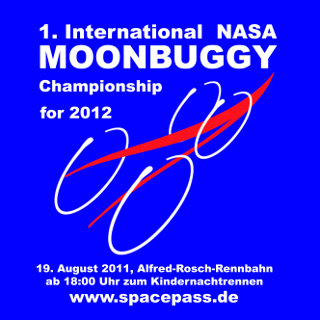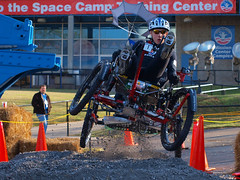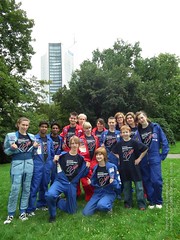| Events - Competitions |
Leipzig’s cycling track hosts young engineering hot shots on August 19th
Leipzig/SEI, August 12th, 2011

The Moonbuggy might not be going to the Moon just yet, but it’s still simulating the challenges of a career at the cutting edge of industry, science and craft – not to mention enthusiasm, health and sports. Next weekend, 4 international Moonbuggy teams from Germany, Russia, India and France will be battling it out in Leipzig to compete for the cup of international NASA teams. Leipzig’s race track is the ideal venue for the recumbent bikes that are speeding up to 80km/h before the annual Children’s Night Race takes off from 6pm. But there’s more to it.
For 5 years the Leipzig-built Moonbuggy has been taking part in the eponymous NASA construction competition. It was the first non-US built vehicle and earned the winning team last year – this year, there were even two vehicles that finished 4th and 6th across the pond. At the same time, 48 Indian teams started at NASA, but none of them finished better than 17th. It’s the same for teams from universities and high schools in Russia, Canada, Romania, Hungary, Malaysia, France and others. So far, no other international educational establishment has been able to inspire and push their students as far as Leipzig’s International Space Education Institute e.V. did.
Sahil Sehgal (22) from New Delhi holds a Master in information technology and was quick to join the first International Summer School in Leipzig. ‘Quality instead of quantity’ was his motto while he spent time in a multidisciplinary team. Yevgeny Sakutin (22) hails from the Urals and finished his aerospace studies as the most distinguished student in his Moscow Aviation University. This summer is his 4th time in Leipzig, and he feels it’s natural to learn abroad and then pass his experience on to his Russian peers in industry and academia. Laurence Ponsot (19) studies engineering in Lyon. She wonders why a high tech nation such as France has not fared better in such an important youth competition, but points out: ‘In Leipzig I found a family you can reach anything with.’
All those international students – 25 by now – have only one goal: ‘To give our best at the first international championship in Leipzig’. But what makes Leipzig so attractive? Dr. Eberhard Rees, 2nd director of NASA’s Marshall Spaceflight Center during the 1970s, studied and worked in Leipzig as a young man. His boss in the Lindenau-based company Meyer & Weichelt, Dr. Curt Weichelt, founded the association of the friends of the commercial college and developed young talents during the 1920s. Today, Marshall Spaceflight Center in the rocket city of Huntsville Alabama is the host of the NASA Moonbuggy Race. Today’s SEI is the same kind of hotbed for talents as Weichelt’s brainchild was then.
Some of those that profit most from this international exposure are the regional German students. Tobias Meier (15) of Portitz high school, Eric Meinel (15) of Kant grammar school or Nadin Rößler of Chemnitz’s Goethe grammar have long crossed the boundaries to the international engineering world and are already on the way to the top. As successful cyclist, Max Frank (17) has found a new goal: ‘The Moonbuggy deserves to be turned into a sport and leisure activity’.
 Am meisten profitieren davon die Leipziger und deutschen Schüler. Tobias Meier (15) aus der Mittelschule Portitz, Eric Meinel (15) aus dem Kantgymnasium oder Nadin Rößler aus dem Chemnitzer Goethegymnasium haben ihre Distanz zum internationalen Ingenieurwesen längst überwunden und mischen bereits ganz oben mit. Max Frank (17) hat als erfolgreicher Radsportler zu einem neuen Ziel gefunden: „Der Moonbuggy verdient es als Sport und in der Freizeit etabliert zu werden“.
Am meisten profitieren davon die Leipziger und deutschen Schüler. Tobias Meier (15) aus der Mittelschule Portitz, Eric Meinel (15) aus dem Kantgymnasium oder Nadin Rößler aus dem Chemnitzer Goethegymnasium haben ihre Distanz zum internationalen Ingenieurwesen längst überwunden und mischen bereits ganz oben mit. Max Frank (17) hat als erfolgreicher Radsportler zu einem neuen Ziel gefunden: „Der Moonbuggy verdient es als Sport und in der Freizeit etabliert zu werden“.
 In the course of preparations for this NASA contest, a 400 strong task list has been developed into a complex project for vocational training. Students with ambitions for technical or science subjects can take up micro-projects that they enjoy and produce parts, software, electronics, handbooks or documentation for the Moonbuggy, guided by professional in-house and external engineers and advisors. They’re motivated to show their work in an international setting, and at the same time gain an understanding of what they’d like to do in the future. Many of them become more focused and organized in the process. Saxony’s Ministry for Culture has hence included work on the Moonbuggy in the framework of formal science projects at high school graduation level.
In the course of preparations for this NASA contest, a 400 strong task list has been developed into a complex project for vocational training. Students with ambitions for technical or science subjects can take up micro-projects that they enjoy and produce parts, software, electronics, handbooks or documentation for the Moonbuggy, guided by professional in-house and external engineers and advisors. They’re motivated to show their work in an international setting, and at the same time gain an understanding of what they’d like to do in the future. Many of them become more focused and organized in the process. Saxony’s Ministry for Culture has hence included work on the Moonbuggy in the framework of formal science projects at high school graduation level.
 A balanced scoring system spurs the students on to achievement, creativity, construction savvy, sports and strategic thinking. Kick-off is at 6pm, and – Formula 1 style – the 4 vehicles will be racing the 1200m with 2 respective drivers on the pedals simultaneously. They start in a collapsed position. The on-site mobile mission control centre will be recording telemetry during the 3-4min races. Data analysis and translation of insights into new vehicles will take the best part of the coming months. Until then, however, the best Moonbuggy pilot will already have been crowned in Leipzig.
A balanced scoring system spurs the students on to achievement, creativity, construction savvy, sports and strategic thinking. Kick-off is at 6pm, and – Formula 1 style – the 4 vehicles will be racing the 1200m with 2 respective drivers on the pedals simultaneously. They start in a collapsed position. The on-site mobile mission control centre will be recording telemetry during the 3-4min races. Data analysis and translation of insights into new vehicles will take the best part of the coming months. Until then, however, the best Moonbuggy pilot will already have been crowned in Leipzig.
Big goals need a big arena – as they are our future. Our great thanks go to all participants, including the hosts of the Children’s Night Race and all regional companies who find their heart in this idea.
More information for students, pupils and parents:
Tel: +49 (0) 172 7949 375
Ralf Heckel, Chairman
| < Prev |
|---|




















































